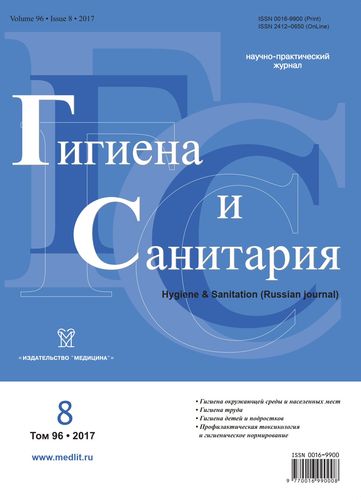Assessment of carcinogenic risk to population health due to high arsenic content in drinking artesian water of the North Dagestan
- Authors: Abdulmutalimova T.O.1, Revich B.A.2
-
Affiliations:
- Centre for Strategic Planning, Russian Ministry of Health
- Institute for Forecasting of the Russian Academy of Science
- Issue: Vol 96, No 8 (2017)
- Pages: 743-746
- Section: ENVIRONMENTAL HYGIENE
- Published: 21.10.2020
- URL: https://archivog.com/0016-9900/article/view/640675
- DOI: https://doi.org/10.47470/0016-9900-2017-96-8-743-746
- ID: 640675
Cite item
Full Text
Abstract
The northern part of the Republic of Daghestan is characterized by high levels of arsenic in artesian drinking water due to peculiarities of the chemical composition of the water-bearing plateaus. The concentrations of arsenic in water samples ranged from 0.01mg/l to 0.5 mg/l. According to current guidelines for arsenic of 0.01 mg/l, the excess in the level of arsenic in water was detected to 20-fold or more in 12 villages with the total population of 15 827 people. To evaluate the cancer health risks from exposure to arsenic we used еру risk assessment method. Lifetime individual cancer risks were shown to be at the minimum concentration (0.01mg/l) — 4.3E-4; at maximum concentration (0.5 mg/l) -2.1E-2, respectively, with a mean of 0.14 mg/l — 6.0E-3. The cancer health risks results were found to be higher than permissible value of 1∙10–6. For the exposed population (309,700 people) annual population cancer health risks ranged from 1 to 94.8 additional cases of possible occurrence of cancer. The results of this study revealed areas with high levels of arsenic in drinking water and determined the exposed portion of population to recognize the implementation of measures for the mitigation of risks.
Keywords
About the authors
Tamila O. Abdulmutalimova
Centre for Strategic Planning, Russian Ministry of Health
Author for correspondence.
Email: amila4@mail.ru
MD, PhD, DSci., Centre for Strategic Planning, Russian Ministry of Health, Moscow, 119991, Russian Federation.
e-mail: tamila4@mail.ru
Russian FederationB. A. Revich
Institute for Forecasting of the Russian Academy of Science
Email: noemail@neicon.ru
Russian Federation
References
- Nordstrom D.K. Public health. Worldwide occurrences of arsenic in ground water. Science. 2002; 296: 2143–5.
- Chetvertikova A.V. What water do the population of the south of Russia drink? Priroda. 2012; (4): 39–43. (in Russian)
- Golubkina N.A., Burtseva T.I., Gatsenko A.Yu. Water quality indices in the Orenburg Region. Gigiena i sanitariya. 2011; 90 (1): 70–4. (in Russian)
- Newsletter about the state of the bowels of the North Caucasus Federal District in 2013. Available at: http://www.south-geomon.ru (in Russian)
- Bezgodov I.V., Efimova N.V., Kuz’mina M.V. Assessment of the quality of drinking water and risk for the population’s health in rural territories in the Irkutsk region. Gigiena i sanitariya. 2015; 94 (2): 15–9. (in Russian)
- Kurbanova L.M., Samedov Sh.G., Gazaliev I.M., Abdulmutalimova T.O. Arsenic in groundwater of the North Dagestan Artesian Basin. Geokhimiya. 2013; (3): 262–4. (in Russian)
- Shiryaeva I.A. Assessing the impact of natural geochemical provinces of Perm Region on the quality of drinking water and the formation of carcinogenic risk to public health. Zdorov’e sem’i – 21 vek. 2013; (3): 13. (in Russian)
- Kon’shina L.G., Lezhnin V.L. Evaluation of the quality of drinking water and public health risk. Gigiena i sanitariya. 2014; 93 (3): 5–10. (in Russian)
- Kleyn S.V., Vekovshinina S.A., Sboev A.S. Priority of drinking water hazards and the associated economic damage. Gigiena i sanitariya. 2016; 95 (1): 10–4. (in Russian)
- Kurbanov M.K. The North-Daghestan Artesian Basin [Severo-Dagestanskiy artezianskiy basseyn]. Makhachkala: Dagknigizdat; 1969. (in Russian)
- Muzahidul I. Hygienic assessment of the prevalence of arsenic in water and food and its impact on the health of the population of Bangladesh (Gazipur area): Diss. Moscow; 2012. (in Russian)
- Naujokas M.F., Anderson B., Ahsan H., Aposhian H.V., Graziano J.H., Thompson C. et al. The Broad Scope of Health Effects from Chronic Arsenic Exposure: Update on a Worldwide Public Health Problem. Environ. Health Perspect. 2013; 121 (2): 295–302.
- Navoni J.A., De Pietri D., Olmos V., Gimenez C., Bovi Mitre G., de Titto E. et al. Human health risk assessment with spatial analysis: Study of a population chronically exposed to arsenic through drinking water from Argentina. Sci. Total. Environ. 2014; 499: 166–74.
- Hughes M.F., Beck B.D., Chen Y., Lewis A.S., Thomas D.J. Arsenic exposure and toxicology: a historical perspective. Toxicol. Sci. 2011; 123: 305–32.
- Huang L., Wu H., van der Kuijp T.J. The health effects of exposure to arsenic-contaminated drinking water: a review by global geographical distribution. Int. J. Environ. Health Res. 2014; 3: 1–21.
- Das N.K., Sengupta S.R. Arsenicosis: Diagnosis and treatment Indian J. Dermatol. Venereol. Leprol. 2008; 74 (6): 571–81.
- Sengupta S.R., Das N.K., Datta P.K. Pathogenesis, clinical features and pathology of chronic arsenicosis. Indian J. Dermatol. Venereol. Leprol. 2008; 74 (6): 559–70.
- Haque R., Mazumder D.N., Samanta S., Ghosh N., Kalman D., Smith M. et al. Arsenic in Drinking Water and Skin Lesions: Dose-Response Data from West Bengal, India. Epidemiology. 2003; 14 (2): 174–82.
- Guidelines for drinking-water quality. Geneva: WHO; 2011.
- Rakhmanin Yu.A., Krasovskiy G.N., Egorova N.A., Mikhaylova R.I. 100 years of legislative regulation of the quality of drinking water. Retrospective, current status and perspective. Gigiena i sanitariya. 2014; 93 (2): 5–17. (in Russian)
- Shabanova Z.E., Kaymarazov A.G., Abdulmutalimova T.O. The methodical aspects of arsenic determination in groundwater by atomic-absorption spectrometry. In: Materials of Spilrain’s III School of Young Scientists. Actual problems of development of renewable energy resources [Materialy III Shkoly molodykh uchenykh im. E.E. Shpil’rayna. Aktual’nye problemy osvoeniya vozobnovlyaemykh energoresursov]. Makhachkala; 2010.
- Guidance of human health risk assessment from environmental chemicals. Moscow; 2004.
Supplementary files









